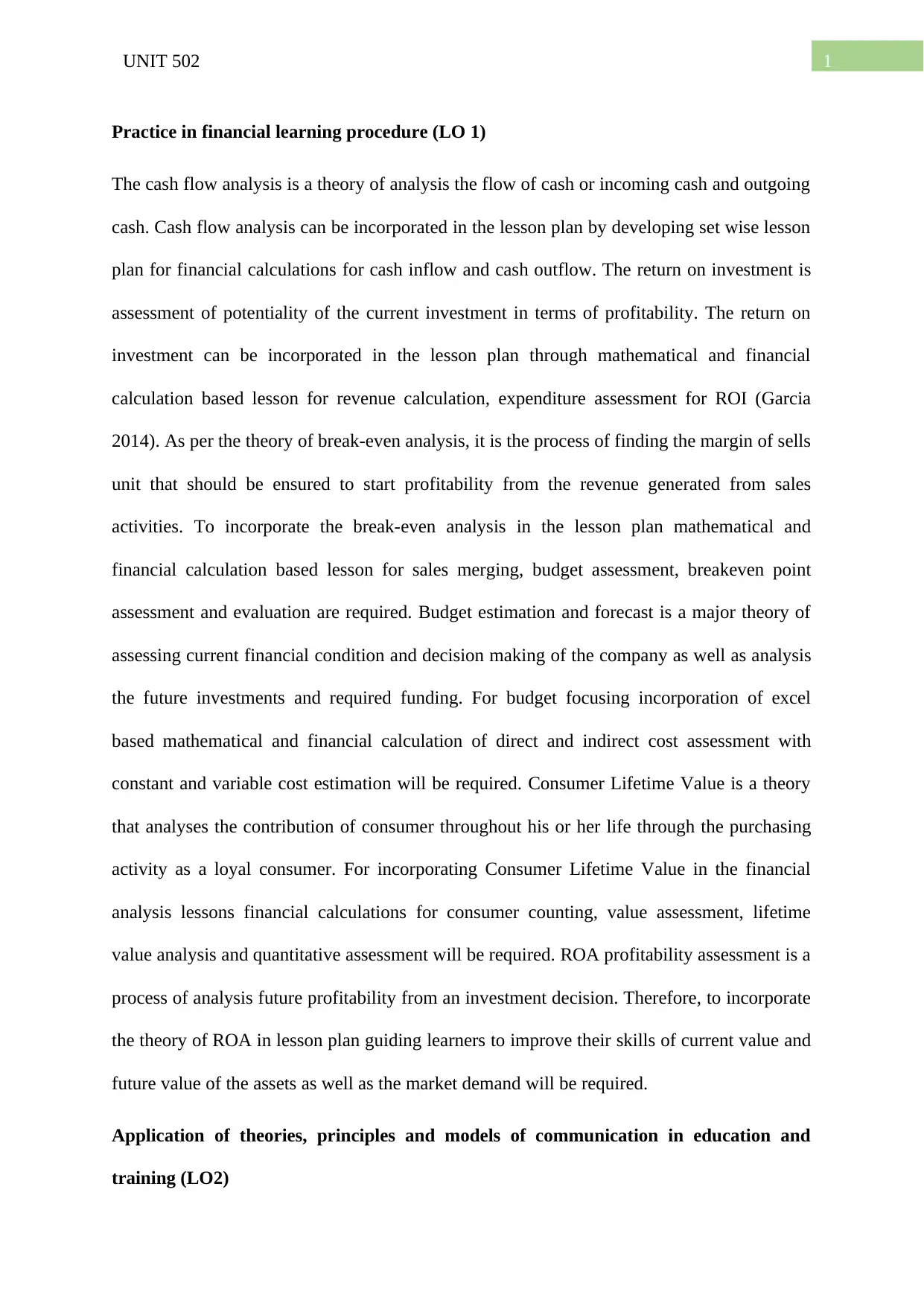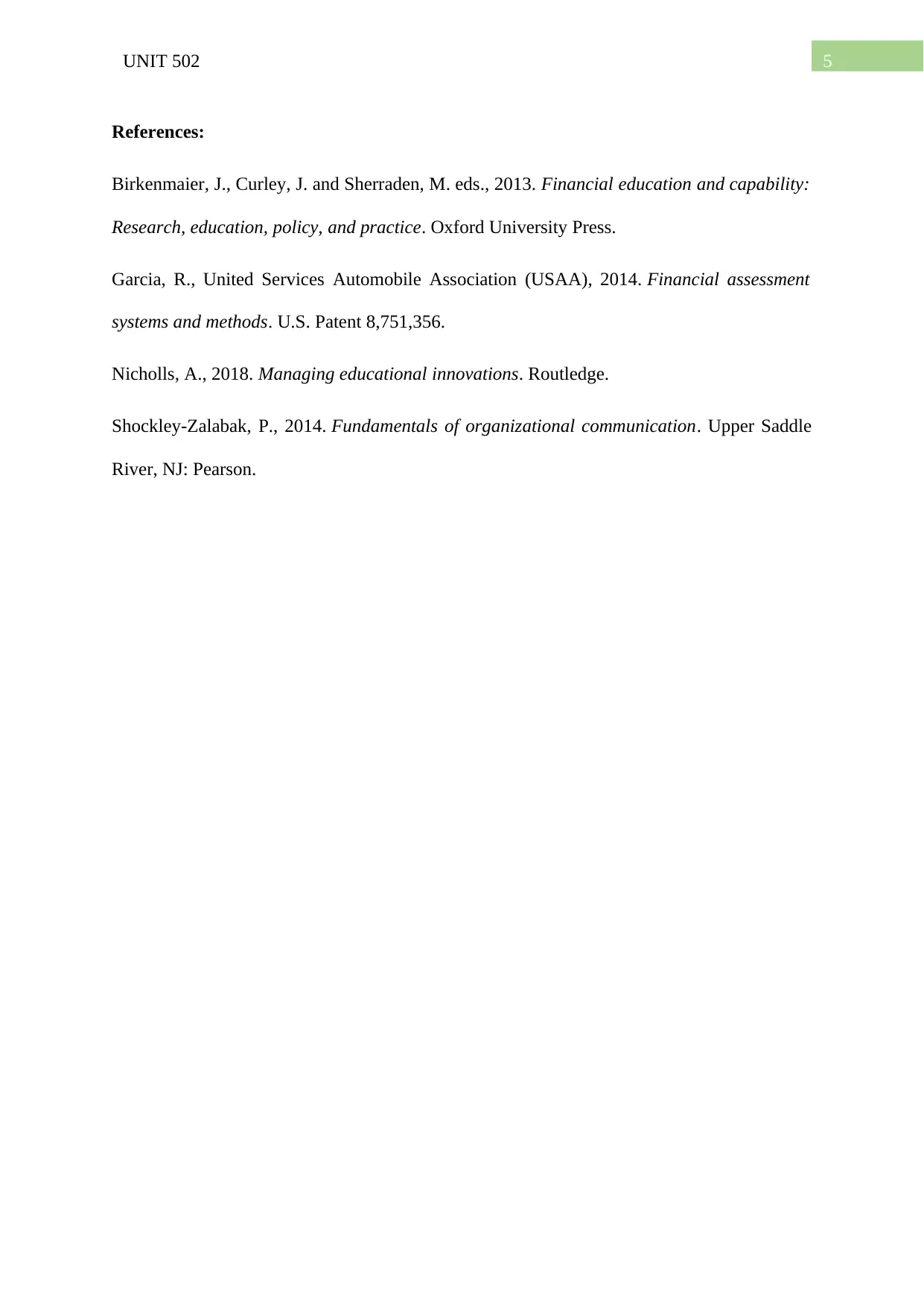Level 5 Diploma in Education and Training: Unit 502 Assignment
VerifiedAdded on 2022/08/27
|6
|1052
|21
Homework Assignment
AI Summary
This assignment, focusing on Unit 502 of a Level 5 Diploma in Education and Training, delves into the application of various theories, principles, and models within the context of education and training. The assignment explores the practical application of financial learning procedures, including cash flow analysis, return on investment, break-even analysis, budget estimation, and consumer lifetime value. It examines communication models, emphasizing interpersonal, formal verbal, and non-verbal communication methods essential for effective teaching and student support. The assignment further investigates assessment strategies, covering feedback, lesson execution, and advanced financial assessment techniques. Additionally, it addresses curriculum development objectives, such as lesson execution, educational communication, and awareness of ethics, safety, and sustainability. The reflection section highlights the effectiveness of communication strategies and identifies strengths and limitations of the discussed topics.

Running head: UNIT 502
Unit 502 Theories, principles and models in education and training
Unit 502 Theories, principles and models in education and training
Paraphrase This Document
Need a fresh take? Get an instant paraphrase of this document with our AI Paraphraser

1UNIT 502
Practice in financial learning procedure (LO 1)
The cash flow analysis is a theory of analysis the flow of cash or incoming cash and outgoing
cash. Cash flow analysis can be incorporated in the lesson plan by developing set wise lesson
plan for financial calculations for cash inflow and cash outflow. The return on investment is
assessment of potentiality of the current investment in terms of profitability. The return on
investment can be incorporated in the lesson plan through mathematical and financial
calculation based lesson for revenue calculation, expenditure assessment for ROI (Garcia
2014). As per the theory of break-even analysis, it is the process of finding the margin of sells
unit that should be ensured to start profitability from the revenue generated from sales
activities. To incorporate the break-even analysis in the lesson plan mathematical and
financial calculation based lesson for sales merging, budget assessment, breakeven point
assessment and evaluation are required. Budget estimation and forecast is a major theory of
assessing current financial condition and decision making of the company as well as analysis
the future investments and required funding. For budget focusing incorporation of excel
based mathematical and financial calculation of direct and indirect cost assessment with
constant and variable cost estimation will be required. Consumer Lifetime Value is a theory
that analyses the contribution of consumer throughout his or her life through the purchasing
activity as a loyal consumer. For incorporating Consumer Lifetime Value in the financial
analysis lessons financial calculations for consumer counting, value assessment, lifetime
value analysis and quantitative assessment will be required. ROA profitability assessment is a
process of analysis future profitability from an investment decision. Therefore, to incorporate
the theory of ROA in lesson plan guiding learners to improve their skills of current value and
future value of the assets as well as the market demand will be required.
Application of theories, principles and models of communication in education and
training (LO2)
Practice in financial learning procedure (LO 1)
The cash flow analysis is a theory of analysis the flow of cash or incoming cash and outgoing
cash. Cash flow analysis can be incorporated in the lesson plan by developing set wise lesson
plan for financial calculations for cash inflow and cash outflow. The return on investment is
assessment of potentiality of the current investment in terms of profitability. The return on
investment can be incorporated in the lesson plan through mathematical and financial
calculation based lesson for revenue calculation, expenditure assessment for ROI (Garcia
2014). As per the theory of break-even analysis, it is the process of finding the margin of sells
unit that should be ensured to start profitability from the revenue generated from sales
activities. To incorporate the break-even analysis in the lesson plan mathematical and
financial calculation based lesson for sales merging, budget assessment, breakeven point
assessment and evaluation are required. Budget estimation and forecast is a major theory of
assessing current financial condition and decision making of the company as well as analysis
the future investments and required funding. For budget focusing incorporation of excel
based mathematical and financial calculation of direct and indirect cost assessment with
constant and variable cost estimation will be required. Consumer Lifetime Value is a theory
that analyses the contribution of consumer throughout his or her life through the purchasing
activity as a loyal consumer. For incorporating Consumer Lifetime Value in the financial
analysis lessons financial calculations for consumer counting, value assessment, lifetime
value analysis and quantitative assessment will be required. ROA profitability assessment is a
process of analysis future profitability from an investment decision. Therefore, to incorporate
the theory of ROA in lesson plan guiding learners to improve their skills of current value and
future value of the assets as well as the market demand will be required.
Application of theories, principles and models of communication in education and
training (LO2)

2UNIT 502
The major communication associated with the financial lesson plan is based on identification
of student’s needs, model of executing the communication method, involvement of external
or external personnel and implication of training and teaching. Therefore, for feedback about
the learning procedures and understanding the Interpersonal communication will be required
with the help of Teachers, educators, educational committee, learners where student will
additionally require the Guideline of communication through handbook and presentations.
For Lesson execution and educational communication the formal verbal and non-verbal
communication will be required with the help of Teachers, educators, educational committee,
learners where student will additionally require the Guideline of communication through
handbook and presentations (Shockley-Zalabak 2014). For additional requirement of
vocational training and referral for students special needs the interpersonal communication
will be required with the help of Teachers, educators, educational committee, learners where
student will additionally require the Guideline of communication through handbook and
presentations. For health and safety and sustainability related operations formal verbal and
non-communication will be required as a part of the guideline of communication through
handbook and presentations with the help of Teachers, educators, educational committee and
learners.
Theories, principles and models of assessment in education and training (LO 3)
The objectives of extra curriculum activities should be based on feedback about the learning
procedures and understanding, lesson execution and educational communication, additional
requirement regarding the lessons and understanding and advanced mathematical financial
assessment. For feedback about the learning procedures and understanding verbal
communication and comprehension test based assessment will be required. For lesson
execution and educational communication verbal lectures and lesson plan, verbal institution
and trainings will be required (Birkenmaier, Curley and Sherraden 2013). Verbal lectures and
The major communication associated with the financial lesson plan is based on identification
of student’s needs, model of executing the communication method, involvement of external
or external personnel and implication of training and teaching. Therefore, for feedback about
the learning procedures and understanding the Interpersonal communication will be required
with the help of Teachers, educators, educational committee, learners where student will
additionally require the Guideline of communication through handbook and presentations.
For Lesson execution and educational communication the formal verbal and non-verbal
communication will be required with the help of Teachers, educators, educational committee,
learners where student will additionally require the Guideline of communication through
handbook and presentations (Shockley-Zalabak 2014). For additional requirement of
vocational training and referral for students special needs the interpersonal communication
will be required with the help of Teachers, educators, educational committee, learners where
student will additionally require the Guideline of communication through handbook and
presentations. For health and safety and sustainability related operations formal verbal and
non-communication will be required as a part of the guideline of communication through
handbook and presentations with the help of Teachers, educators, educational committee and
learners.
Theories, principles and models of assessment in education and training (LO 3)
The objectives of extra curriculum activities should be based on feedback about the learning
procedures and understanding, lesson execution and educational communication, additional
requirement regarding the lessons and understanding and advanced mathematical financial
assessment. For feedback about the learning procedures and understanding verbal
communication and comprehension test based assessment will be required. For lesson
execution and educational communication verbal lectures and lesson plan, verbal institution
and trainings will be required (Birkenmaier, Curley and Sherraden 2013). Verbal lectures and
⊘ This is a preview!⊘
Do you want full access?
Subscribe today to unlock all pages.

Trusted by 1+ million students worldwide

3UNIT 502
lesson plan, verbal institution and trainings will be also required for additional requirement
regarding the lessons and understanding. For advanced mathematical financial assessment as
model of teaching numerical Tests and verbal questionnaires will be required.
Theories, principles and models of assessment in curriculum development for finance
(LO 4)
Curriculum development needs several sets of objectives, however the major objectives are
lesson execution and educational communication based extra curriculum and additional
requirement regarding the lessons and understanding, developing awareness about ethics,
safety, and sustainability. To use curriculum based activity for lesson execution and
educational communication audio-visual presentation through projector and sound system
will be required as a part of simulation or role playing game (Nicholls 2018). To use external
non-verbal activities for increasing proficiency for educational communication Group based
playful activities and cooperative assignments will be required. In order to develop
awareness about ethics, safety, sustainability through curriculum based activity group based
simulator oriented practices and recreational activities will be required.
Reflection (LO 5)
According to theory of communication both interpersonal and formal communication is
effective for knowledge sharing and awareness building. In this unit both of these
communication strategies has been used for training, development and improvement. The
advantages of this paper is its selection of major health, safety, sustainability and diversity
components. The limitations of this presentation are the lack of details in lesson planning and
assessment planning, lack of presentation regarding regulatory compliances and resource
allocation and lack of practicality. The detailed planning of utilised tools has not been
incorporated.
lesson plan, verbal institution and trainings will be also required for additional requirement
regarding the lessons and understanding. For advanced mathematical financial assessment as
model of teaching numerical Tests and verbal questionnaires will be required.
Theories, principles and models of assessment in curriculum development for finance
(LO 4)
Curriculum development needs several sets of objectives, however the major objectives are
lesson execution and educational communication based extra curriculum and additional
requirement regarding the lessons and understanding, developing awareness about ethics,
safety, and sustainability. To use curriculum based activity for lesson execution and
educational communication audio-visual presentation through projector and sound system
will be required as a part of simulation or role playing game (Nicholls 2018). To use external
non-verbal activities for increasing proficiency for educational communication Group based
playful activities and cooperative assignments will be required. In order to develop
awareness about ethics, safety, sustainability through curriculum based activity group based
simulator oriented practices and recreational activities will be required.
Reflection (LO 5)
According to theory of communication both interpersonal and formal communication is
effective for knowledge sharing and awareness building. In this unit both of these
communication strategies has been used for training, development and improvement. The
advantages of this paper is its selection of major health, safety, sustainability and diversity
components. The limitations of this presentation are the lack of details in lesson planning and
assessment planning, lack of presentation regarding regulatory compliances and resource
allocation and lack of practicality. The detailed planning of utilised tools has not been
incorporated.
Paraphrase This Document
Need a fresh take? Get an instant paraphrase of this document with our AI Paraphraser

4UNIT 502

5UNIT 502
References:
Birkenmaier, J., Curley, J. and Sherraden, M. eds., 2013. Financial education and capability:
Research, education, policy, and practice. Oxford University Press.
Garcia, R., United Services Automobile Association (USAA), 2014. Financial assessment
systems and methods. U.S. Patent 8,751,356.
Nicholls, A., 2018. Managing educational innovations. Routledge.
Shockley-Zalabak, P., 2014. Fundamentals of organizational communication. Upper Saddle
River, NJ: Pearson.
References:
Birkenmaier, J., Curley, J. and Sherraden, M. eds., 2013. Financial education and capability:
Research, education, policy, and practice. Oxford University Press.
Garcia, R., United Services Automobile Association (USAA), 2014. Financial assessment
systems and methods. U.S. Patent 8,751,356.
Nicholls, A., 2018. Managing educational innovations. Routledge.
Shockley-Zalabak, P., 2014. Fundamentals of organizational communication. Upper Saddle
River, NJ: Pearson.
⊘ This is a preview!⊘
Do you want full access?
Subscribe today to unlock all pages.

Trusted by 1+ million students worldwide
1 out of 6
Your All-in-One AI-Powered Toolkit for Academic Success.
+13062052269
info@desklib.com
Available 24*7 on WhatsApp / Email
![[object Object]](/_next/static/media/star-bottom.7253800d.svg)
Unlock your academic potential
Copyright © 2020–2025 A2Z Services. All Rights Reserved. Developed and managed by ZUCOL.

